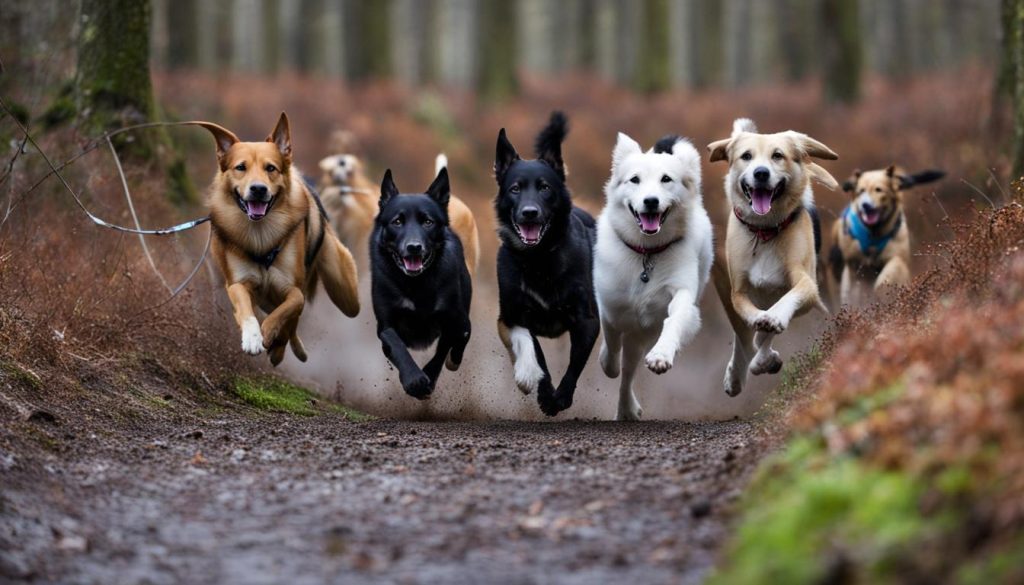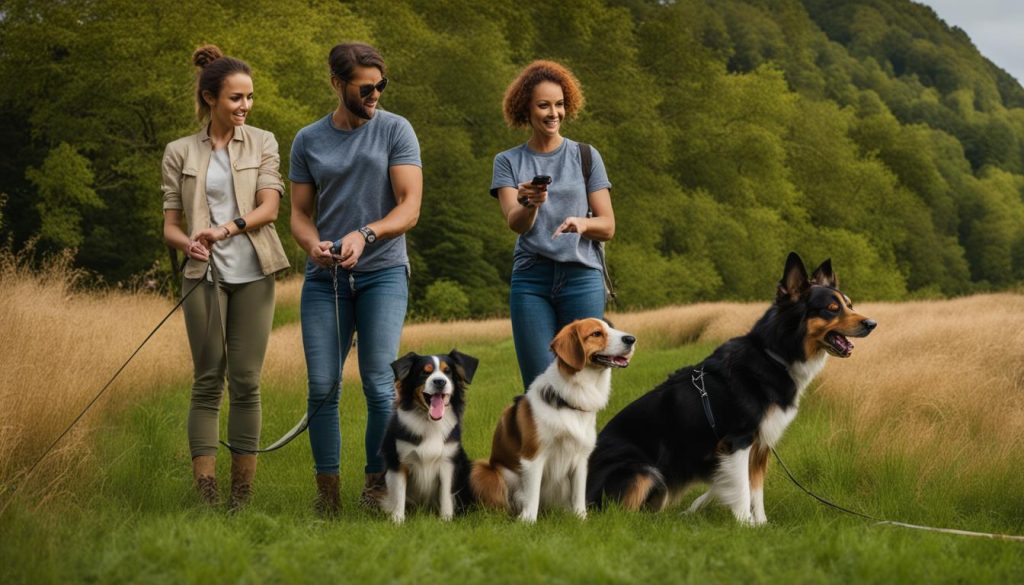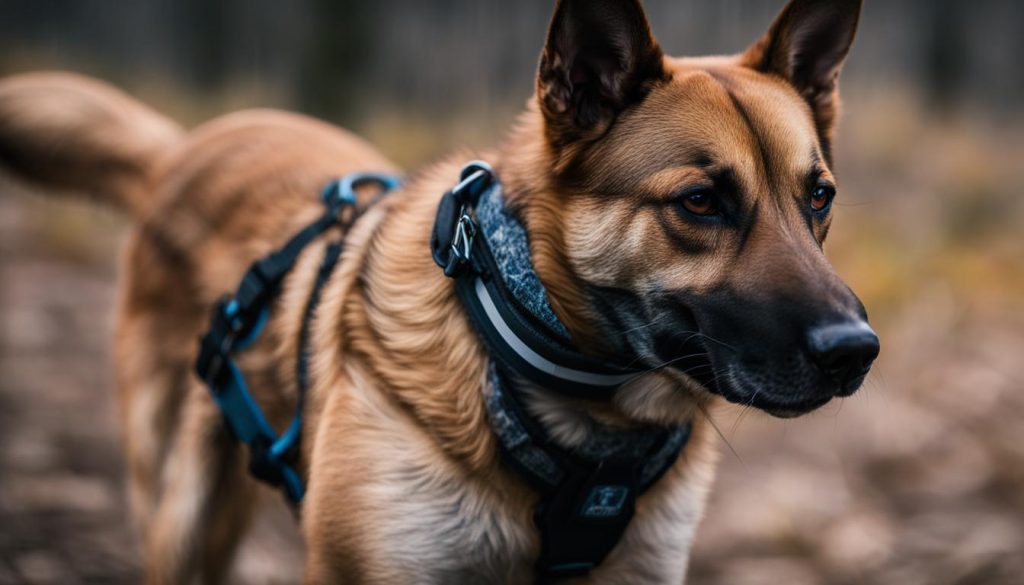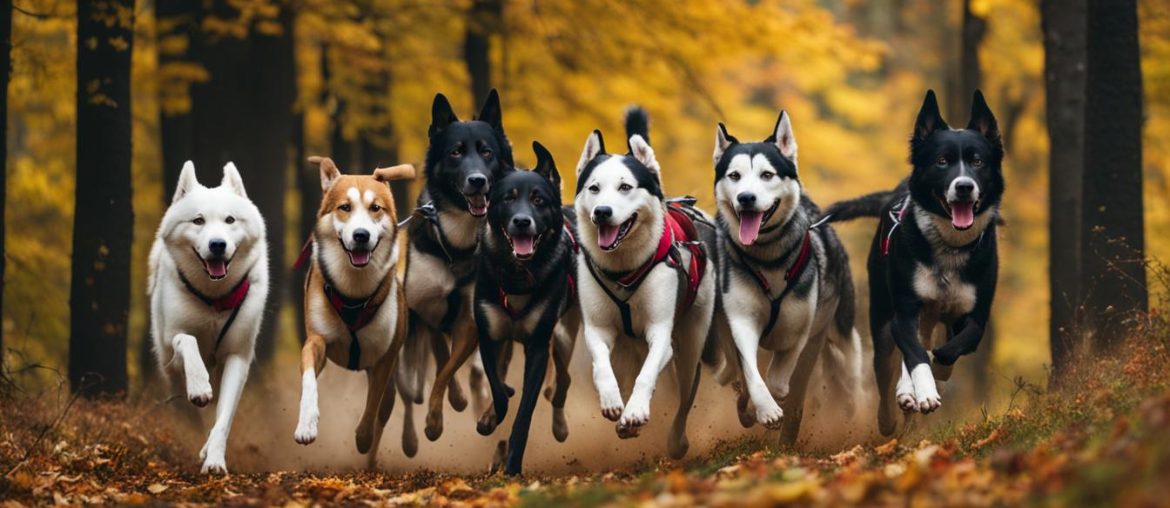Running can be a great activity for dogs and their owners to bond and stay active. However, not all dog breeds are suitable for canicross, a sport that involves running and hiking with dogs. You should consider factors such as the dog’s age, health, energy level, and physical characteristics. Based on these criteria, we have compiled a list of canicross-friendly dog breeds that make excellent running companions.
Key Takeaways:
- Canicross is a sport that involves running and hiking with dogs.
- Not all dog breeds are suitable for canicross, so consider factors such as age, health, energy level, and physical characteristics.
- There are canicross-friendly dog breeds that make excellent running companions.
- Choosing the right dog breed is crucial for a safe and enjoyable canicross experience.
- Consulting with a veterinarian or experienced canicross trainers can provide valuable insights and recommendations for selecting the right breed.
Factors to Consider Before Running with Your Dog
Before you embark on a canicross adventure with your dog, there are several factors to consider. Running with a dog requires careful planning and consideration to ensure the safety and well-being of both you and your furry companion. The following factors should be taken into account before hitting the trails together:
- Age: The age of your dog plays a crucial role in determining their readiness for running. Puppies should not be taken for runs until their bones and joints have fully developed, which typically occurs around one year of age.
- Health: You should assess your dog’s overall health and consult with a veterinarian before starting a canicross routine. Your vet can provide valuable insights into your dog’s physical condition and ensure that running is safe for them.
- Energy Level: Consider your dog’s energy level and stamina. Some breeds are naturally more energetic and have higher endurance levels, while others may be better suited to shorter, less intense runs. Matching your dog’s energy level to your own will lead to a more enjoyable running experience for both of you.
- Physical Characteristics: Your dog’s physical traits can also impact their ability to run comfortably and safely. Factors such as leg length, body size, coat thickness, bone structure, and snout length should be taken into consideration. For example, brachycephalic breeds with short snouts may have difficulty regulating their body temperature during strenuous exercise.
By carefully considering these factors, you can ensure that running with your dog is a positive and enjoyable experience for both of you. Always prioritize your dog’s well-being and consult with professionals for any specific concerns or questions you may have.

Quote:
“Running with your dog can be a wonderful bonding experience, but make sure that both you and your four-legged friend are ready for it. Take the time to assess your dog’s age, health, energy level, and physical characteristics to determine if running is suitable for them. Once you’ve done that, you’ll be on your way to enjoying many happy miles together.”
Now that you understand the factors to consider before running with your dog, the next sections will explore canicross-friendly breeds for beginners, advanced runners, different weather conditions, and low-shedding options. Each section will provide insights and recommendations to help you find the perfect running companion for your canicross adventures.
Canicross Dog Breeds for Beginners
When starting out in canicross, choose a dog breed that is suitable for beginners. These breeds have the energy, temperament, and endurance to enjoy running with their owners without being too challenging for novices. Here are some of the best canicross dog breeds for beginners:
- Labrador Retrievers: Known for their friendly and outgoing nature, Labradors make excellent companions for canicross. They have high energy levels and are eager to please, making them easy to train.
- Dalmatians: With their unique coat pattern and athleticism, Dalmatians are well-suited for canicross. They have a high energy level and love to run, making them ideal running partners.
- Vizslas: This breed is known for their energy, endurance, and love for physical activities. Vizslas are highly trainable and bond closely with their owners, making them great canicross partners.
- German Shorthaired Pointers: These dogs are known for their agility, stamina, and versatility. German Shorthaired Pointers are highly active and require regular exercise, making them excellent candidates for canicross.
- English Springer Spaniels: Spaniels are known for their boundless energy and love for outdoor activities. English Springer Spaniels are no exception, and their friendly nature makes them great running companions.
These canicross dog breeds for beginners offer a balance of energy, adaptability, and trainability, which are key qualities for a successful canicross experience. Try to gradually increase the distance and intensity of your runs to build up your dog’s endurance and fitness level. With patience, consistency, and the right breed, you and your furry friend will enjoy many adventures together in the exciting world of canicross.

Table: Canicross Dog Breeds for Beginners
| Breed | Energy Level | Trainability | Temperament |
|---|---|---|---|
| Labrador Retrievers | High | Easy | Friendly, outgoing |
| Dalmatians | High | Moderate | Energetic, athletic |
| Vizslas | High | Easy | Energetic, affectionate |
| German Shorthaired Pointers | High | Moderate | Agile, versatile |
| English Springer Spaniels | High | Easy | Friendly, outgoing |
Canicross Dog Breeds for Advanced Runners
For advanced runners who are looking to take their canicross experiences to the next level, there are certain dog breeds that are well-suited to meet the demands of high-energy and challenging runs. These breeds possess the athleticism, endurance, and agility to keep up with the pace and intensity of advanced canicross. Here are some of the best canicross dog breeds for advanced runners:
| Breed | Description |
|---|---|
| Weimaraner | A versatile and athletic breed known for its speed and endurance. Weimaraners are highly trainable and make excellent running partners for advanced canicross. |
| Rhodesian Ridgeback | A strong and muscular breed originally bred for hunting. Ridgebacks have pretty good endurance and are well-suited for long-distance canicross. |
| Belgian Malinois | An intelligent and driven breed often used in police and military work. Malinois are highly energetic and require a lot of exercise, making them ideal for advanced canicross. |
| Doberman Pinscher | A sleek and powerful breed known for its speed and agility. Dobermans have a strong work ethic and excel in high-intensity activities like canicross. |
| American Foxhound | A scent hound breed with exceptional endurance and speed. Foxhounds have a strong prey drive and thrive in challenging running environments. |
Canicross Breeds with High Energy
When it comes to advanced canicross, high energy levels are essential to keep up with the rigorous demands of intense runs. These breeds have energy to spare and are always up for a challenging canicross adventure:
- Border Collie
- Australian Shepherd
- Vizsla
- Jack Russell Terrier
- Siberian Husky
These breeds thrive on physical activity and will push the limits alongside advanced runners. However, their high energy levels require consistent training, mental stimulation, and regular exercise to keep them happy and well-behaved.
“Running with a high-energy dog breed is a rewarding experience for both the dog and the owner. The bond that forms during intense canicross runs is truly special.” – Experienced Canicross Runner
When considering advanced canicross breeds, please remember that each dog is unique, and individual characteristics and training play a significant role in their ability to excel in advanced canicross. It’s recommended to consult with experienced canicross trainers or fellow advanced runners to ensure the chosen breed aligns with personal goals and preferences.
Canicross Dog Breeds for Various Weather Conditions
When participating in canicross, consider the weather conditions and choose a dog breed that can handle different climates. Whether you’re running in cold, warm, or hot weather, there are canicross breeds that are well-suited for each condition.
In colder climates, breeds such as Siberian Huskies, Alaskan Malamutes, and German Shepherds thrive. These breeds have thick, double coats that provide insulation and protection against the cold. Their endurance and ability to regulate body temperature make them ideal companions for canicross in chilly environments.
On the other hand, in warmer climates, breeds like Weimaraners, Vizslas, and Dalmatians excel. These breeds have shorter coats and are better equipped to handle higher temperatures. Their lean bodies and efficient cooling mechanisms allow them to run comfortably in warmer weather without overheating.
| Canicross Breeds for Cold Weather | Canicross Breeds for Warm Weather |
|---|---|
| Siberian Husky | Weimaraner |
| Alaskan Malamute | Vizsla |
| German Shepherd | Dalmatian |
You should also prioritize your dog’s comfort and safety when selecting a breed for canicross in different weather conditions. By choosing a breed that can handle the climate you’ll be running in, you can ensure a more enjoyable and successful canicross experience for both you and your furry running partner.
Low-shedding Canicross Dog Breeds
In the world of canicross, finding a dog breed that doesn’t shed excessively can be a game-changer. It not only means less fur on your clothes and furniture but also makes it easier to maintain a clean and allergen-free home. If you’re looking for a low-shedding canicross companion, consider the following breeds:
| Breed | Shedding Level | Hypoallergenic |
|---|---|---|
| Poodle | Minimal shedding | Yes |
| Portuguese Water Dog | Minimal shedding | Yes |
| Australian Terrier | Minimal shedding | No |
Poodles are known for their curly, non-shedding coats, making them an excellent choice for individuals with allergies. They come in different sizes, so you can find a poodle that matches your running needs. Portuguese Water Dogs also have non-shedding coats and are hypoallergenic, making them ideal for canicross enthusiasts with allergies. Australian Terriers are not completely hypoallergenic, but they have a wiry, low-shedding coat that requires regular grooming to prevent matting.
These low-shedding canicross breeds have the added benefit of being highly intelligent, trainable, and energetic. They thrive on physical activity and make excellent running companions. However, even low-shedding breeds require regular grooming to keep their coats healthy and free of tangles.
To put it simply, selecting a low-shedding canicross breed is a personal choice, and consider other factors such as energy level, temperament, and compatibility with your running style before making a decision.

Why Consider Hypoallergenic Breeds?
Hypoallergenic canicross breeds, such as Poodles and Portuguese Water Dogs, are often a top choice for individuals with allergies or asthma. These breeds produce fewer allergens, making them more compatible with allergy sufferers. However, while hypoallergenic breeds may reduce the likelihood of triggering allergies, they won’t eliminate the risk entirely. It’s recommended to spend time with hypoallergenic breeds before committing to ensure that they don’t cause any allergic reactions.
Tips for Choosing the Right Canicross Dog Breed
When it comes to selecting the perfect canicross dog breed, there are several factors to consider. The breed you choose should not only align with your running style and pace but also be compatible with your preferred weather conditions. Additionally, understanding your dog’s temperament, energy level, and physical traits is crucial to ensure a harmonious and safe canicross experience.
In order to choose the right canicross dog breed, consider the following factors:
- Running Style and Pace: Are you a beginner or an advanced runner? Do you prefer short sprints or longer distances? Certain breeds may be better suited for different running styles and paces, so match your energy levels and preferences with those of your future running partner.
- Weather Conditions: If you live in a hot climate, breeds with shorter snouts such as Weimaraners or Vizslas may struggle to regulate their body temperature during runs. On the other hand, breeds with thick fur like Siberian Huskies or Alaskan Malamutes may excel in colder weather conditions.
- Temperament: Different breeds have different temperaments, which can influence their behavior during runs. Some breeds may be more focused and disciplined, while others may be more easily distracted. Consider your own personality and running goals when selecting a breed with a compatible temperament.
- Energy Level: I recommend that you match your energy level with that of your canicross dog breed. If you prefer high-intensity runs, consider breeds known for their energy and endurance, such as Belgian Malinois or Doberman Pinschers. For a more relaxed running experience, breeds like Labrador Retrievers or English Springer Spaniels may be a better fit.
By taking these factors into consideration and weighing them against your own preferences and capabilities, you can make an informed decision when choosing the right canicross dog breed. To put it simply, seeking guidance from experienced canicross trainers or consulting with a veterinarian can provide valuable insights and recommendations as well.

Table: Canicross Dog Breed Considerations
| Consideration | Factors to Consider |
|---|---|
| Running Style and Pace | Beginner or advanced runner, preferred distance, and pace. |
| Weather Conditions | Hot or cold climate, coat thickness, snout length. |
| Temperament | Focused or easily distracted, compatible with owner’s behavior. |
| Energy Level | High-energy or more relaxed, matching owner’s energy level. |
Considering these factors will help you find a canicross dog breed that not only complements your running style but also ensures a safe and enjoyable experience for both you and your furry companion.
Preparing Your Dog for Canicross
Before embarking on canicross activities, it is good practice to prepare your dog both physically and mentally. Proper preparation ensures a safe and enjoyable experience for both you and your furry companion. Here are some important tips to help you get started:
- Gradual Conditioning: Just like humans, dogs need time to build up their endurance and fitness level. Start with short runs and gradually increase the distance and intensity over time. This allows your dog’s muscles, joints, and cardiovascular system to adapt to the physical demands of canicross.
- Training and Commands: Teach your dog basic commands such as “heel,” “stop,” and “go” to ensure they understand and follow your instructions during the run. Consistent training sessions will help your dog become more obedient and responsive, enhancing the safety and enjoyment of the canicross experience.
- Proper Gear: Invest in appropriate canicross gear for your dog, including a well-fitted canicross harness and a waist belt for yourself. The harness should provide comfort, support, and freedom of movement for your dog, while the waist belt allows you to maintain control without strain on your back or shoulders.
- Hydration and Nutrition: Ensure your dog is properly hydrated before, during, and after each run. Carry a portable water bottle and a collapsible bowl to provide water for your dog during breaks. Additionally, consult with a veterinarian to determine the appropriate nutrition and feeding schedule for your dog’s energy needs.
By following these tips and gradually introducing your dog to canicross, you can help them build the necessary strength, endurance, and obedience for a successful and enjoyable running partnership. Try to always prioritize your dog’s safety and well-being during every canicross session.

Canicross Training Tips:
Aside from physical preparation, here are some additional canicross training tips to keep in mind:
- Start with shorter runs and gradually increase the duration and intensity.
- Allow for proper warm-up and cool-down exercises to prevent injuries.
- Vary your running routes to keep your dog mentally stimulated.
- Pay attention to your dog’s body language and adjust the pace if needed.
- Always run in safe and dog-friendly environments, away from traffic and hazards.
By incorporating these training tips into your canicross routine, you can ensure a positive and rewarding experience for you and your four-legged running partner.
Final Thoughts
Canicross is an exhilarating activity that allows dogs and their owners to engage in physical exercise, strengthen their bond, and appreciate the beauty of the great outdoors. When choosing a canicross dog breed, it is vital to consider factors such as age, health, energy level, and physical characteristics. By taking these elements into account, you can find a breed that will provide a safe and enjoyable canicross experience.
For beginners, Labrador Retrievers, Dalmatians, Vizslas, German Shorthaired Pointers, and English Springer Spaniels are recommended canicross dog breeds. These breeds possess the energy, endurance, and temperament suitable for novice runners.
Advanced runners seeking more challenging canicross adventures can consider breeds like Weimaraners, Rhodesian Ridgebacks, Belgian Malinois, Doberman Pinschers, and American Foxhounds. These breeds are known for their athleticism, endurance, and agility, making them ideal running companions for experienced individuals.
Try to consult with a veterinarian and seek guidance from experienced canicross trainers when selecting and preparing your dog for canicross. With the right breed and proper training, canicross can be a rewarding and fulfilling activity for both you and your furry running partner.
FAQ
What factors should I consider before running with my dog?
Before running with your dog, you should consider factors such as their age, health, energy level, and physical characteristics. You should ensure that running is safe and suitable for your dog.
What are some canicross dog breeds for beginners?
Some canicross dog breeds that are suitable for beginners include Labrador Retrievers, Dalmatians, Vizslas, German Shorthaired Pointers, and English Springer Spaniels. These breeds have the energy and temperament for running with beginners.
What are some canicross dog breeds for advanced runners?
For advanced runners, some canicross dog breeds that are more challenging and can keep up with a faster pace include Weimaraners, Rhodesian Ridgebacks, Belgian Malinois, Doberman Pinschers, and American Foxhounds. These breeds are known for their athleticism and endurance.
What are some canicross dog breeds for different weather conditions?
Some canicross dog breeds that do well in cold weather include Siberian Huskies, Alaskan Malamutes, and German Shepherds. Breeds like Weimaraners, Vizslas, and Dalmatians are more suited for running in warmer climates.
Are there any low-shedding canicross dog breeds?
Yes, some low-shedding canicross dog breeds include Poodles, Portuguese Water Dogs, and Australian Terriers. These breeds have hair-like coats that shed less compared to other breeds.
How do I choose the right canicross dog breed?
When choosing the right canicross dog breed, consider factors such as your running style, pace, preferred weather conditions, and the dog’s temperament, energy level, and physical traits. Seeking guidance from a veterinarian or experienced canicross trainers can also be helpful.
How can I prepare my dog for canicross?
To prepare your dog for canicross, gradually increase their exercise and running routine, use proper canicross equipment, and ensure their safety and comfort during the activity. Regular training, hydration, nutrition, and recovery are also important for their overall health and performance.






